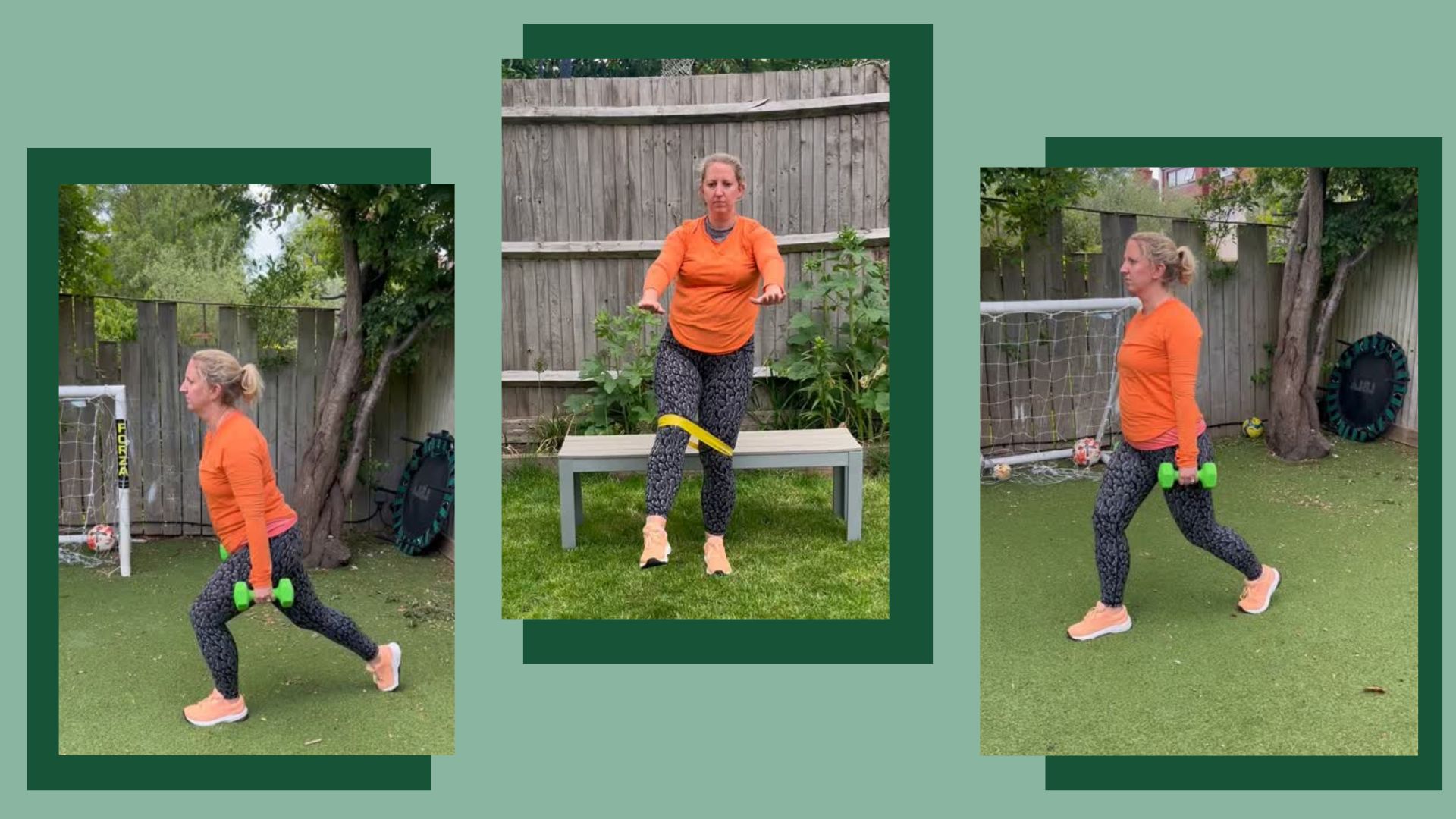I swapped regular squats for these 5 quadricep exercises to boost my lower-body strength - and they worked just as well
They might be some of the larger muscles in the lower body, but you wouldn't be the only one to forget your quadricep exercises in your workout

Quadricep exercises target the quadriceps - a group of muscles sitting on the front of your thighs. If you've done one too many squats in the gym or had to climb more stairs than you'd like, you'll be familiar with the burn that comes from working these muscles more than normal.
I started adding strength training to my workouts in my 30s, and I've come to love it. However, I'm guilty of sticking to what I can do and working some body parts more than others. My upper-body dumbbell workout is a favourite, and I like to do core exercises. My thighs? Not so much.
Though challenging, as you have to "train with intensity to really develop your quadricep muscles and force them to grow", strong thigh muscles are essential for daily life and improving in other exercises, like hiking or running, says Aoife Okonedo Martin, a certified personal trainer from Ultimate Performance.
I vowed to overhaul my routine from my back garden, using a simple pair of dumbbells and a resistance band for company. To discover exercises (aside from a classic squat) that worked for me, I spoke to personal trainers and strength specialists.
My quadricep exercises
1. Walking lunges
Walking lunges are very effective at working your quads. As you have to keep your body stable on the move, they are also excellent for improving balance and stability, as I have learnt.
Though they're not my favourite, I was familiar with this exercise before getting started, so I felt comfortable picking up my dumbbells from the first set.
Here's how to do a walking lunge with weights:
Sign up to our free daily email for the latest royal and entertainment news, interesting opinion, expert advice on styling and beauty trends, and no-nonsense guides to the health and wellness questions you want answered.
- Stand holding the dumbbells in both hands, core engaged.
- Step forward on one leg until your knee comes parallel with the floor.
- Keep your weights from swinging as you move by contracting your shoulder blades, bringing them back and down. Look forward.
- Push up from your heel and take a step forward in one motion.
- Repeat these at least 5 times on boths legs, before resting for 45-seconds. Repeat for 3 sets.
2. Reverse lunge
Reverse lunges (also known as split squats) are one of the 'must-have' exercises to strengthen the quadriceps. "I rate the split squat so highly, it's rare a client doesn't have the exercise programmed into their first training phase," Martin tells me.
"There are very few exercises that produce the results in strength, size, flexibility, and structural balance that the split squat can do all at once," she adds.
Here's how to do a split squat:
- Hold a dumbbell in each hand.
- Stand with your feet shoulder-width apart, then step forwards with one foot.
- Keep your hips straight, and raise your back heel off the ground.
- Lower your back knee, keeping your front knee in line with your ankle.
- Use both legs to push back up to your starting position.
- Try to do three sets of 10 on each leg with a 1 minute rest between each set.
3. Single leg stand
I'm not even going to try and guess how many times I tried this exercise before I did it without falling over. But, I'd say it's one of the best quadriceps exercises on my list as it works each leg individually. Doing this means you won't have one leg stronger than the other.
It was also the quadriceps exercise that I was left feeling the most 'burn' from afterwards.
Here's how to do the single-leg stand with a resistance band:
- byStart from sitting with your legs bent at 90 degrees on a chair or bench
- Put the resistance band around your legs, just above the knee.
- Tilt forward slightly and lift one leg off the floor by a couple of inches.
- With your arms out in front of you, stand up on one leg.
- Slowly sit back down again and repeat on this leg 10 times.
- Swap to the other leg and do the same.
- Aim for three sets on each leg.
4. Lateral band walk
The lateral band walk (aka. the 'crab' walk) is traditionally a glute exercise. However, it also works the quads and hip flexors, making it an all-around excellent lower-body movement to include in a resistance band workout.
I tried this one on a few sunny days in the garden while chatting to my children, who were playing football. I think they thought I was mad, crab-walking across the grass, but I could feel my quads working hard, even after just a few minutes.
Here's how to do a lateral band walk:
- Put the band around your legs, just above your knee.
- Stand with your legs hip-width apart.
- Squat down and take a small step to the right.
- Keep your legs apart as you take small steps for 30 seconds.
- After 30 seconds, start walking back in the opposite direction.
- Try to do three sets with 45 seconds rest between.
5. Goblet squats
I had to include a couple of squats in the mix, but these are alternatives to the classic bodyweight or barbell squat.
The goblet squat is “one of the best exercises for targeting the quadriceps," says PT and strength training specialist Anya Russell.
“It also works the hamstrings, glutes and core, making it a compound movement beneficial for overall lower-body strength,” she says.
This type of squat engages all four muscles in your quads, and it can be done with a dumbbell or kettlebell. I tried it with a 10kg dumbbell, which really intensified things. My quads were shaking by the end of the sets.
Here's how to do a goblet squat:
- Hold your weight with two hands just below your chin.
- Stand with your feet shoulder-width apart, with your toes pointing outwards slightly.
- Bend your knees until your thighs are parallel to the ground, or as low as you can.
- Hold for a second or two and then push back up to standing.
- Try to do three sets of 10 to 12 squats with a 45-second rest between.
6. Spanish squats
A Spanish squat isn't just a great way to target and strengthen the quads, says Russell, "it's also a low-impact exercise for those with knee pain."
They are particularly effective at isolating the quads and can be used to reinforce proper knee positioning, reducing strain on the joints, she says.
Here's how to do a Spanish squat with a resistance band:
- Loop a resistance band around a stable structure, like a pole or tree.
- Stretch the band around the backs of your knees and move back until it’s taut.
- Squat down as far as you can with your arms stretched in front of you.
- Hold the squat for a few seconds before returning to standing.
- Try three sets of 10 squats with 45 seconds of rest between.
Quadricep exercises with machines
Prefer to do your quadricep exercises in the gym? Make use of equipment like the leg press, leg extension, and hack squat machines.
1. Leg press
Regular gym users will be familiar with the leg press machine. It’s a good one for beginners because you can adjust the weights easily, and it takes the pressure off your knees because it’s done from a sitting position.
Martin says: “The leg press is excellent for targeting the quads, especially when foot placement is adjusted [lower on the footplate and a narrower stance] to emphasise quadriceps engagement.”
2. Leg extension machine
The leg extension works by extending the knee from bent to straight with weight on top of your lower legs. “This isolation exercise focuses solely on the quadriceps, making it ideal for muscle activation and hypertrophy (growing muscle cells),” says Martin.
Make sure the machine is adjusted properly. The pad by your feet should sit comfortably in the crook of your ankle, and your knees should be in line with the bottom of the seat pad for support.
3. Hack squat machine
A hack squat "allows for controlled squat movement, placing significant emphasis on the quadriceps while reducing strain on the lower back," says Martin.
While using a barbell to squat will engage more muscles as you're forced to maintain your own balance, a hack squat is an easy way to isolate your thigh muscles.
Can you do quadriceps exercises with bad knees?
My knees have become more sore and achy over the last few years, so I knew I needed to be careful doing some of these exercises, so I didn’t injure myself. If you have knee problems, speak to your doctor or a physio before including quadriceps exercise in your workouts.
If you’ve had knee surgery, a physiotherapist will recommend suitable exercises.
It’s often highly beneficial to train your quads even if you have bad knees, says Martin. You just need to be careful how you do it.
“Strengthening the quadriceps can actually help support and stabilise the knee joint, potentially reducing pain and improving function over time,” she explains. “The key is to choose exercises that minimise strain, such as controlled movements on machines like the leg press or leg extension, where the range of motion and resistance can be carefully adjusted.”
Russell suggests making modifications like these in your quadricep exercises:
- TRX-Assisted Squats: Using suspension trainers to reduce knee strain.
- Partial range leg extensions: Limiting the range of motion to avoid discomfort.
- Straight leg raises: Strengthen the quads without bending the knee.
Does walking uphill strengthen your quadriceps?
Yes, walking uphill is an alternative quadricep exercise as you have to work harder to move up the incline. If you added one of the best weighted vests or ankle weights for walking to your workout, you'll see even more progress.
"When you walk uphill, your body works against gravity, which increases the load on your quads. This makes them work harder than they would on flat ground," says Russell. "Over time, this added resistance helps build strength and endurance in these muscles, as well as the glutes, calves, and hamstrings."
How do you know if you have weak quadriceps?
- Knee pain or discomfort, especially when walking downstairs, squatting or standing up from a chair
- Unstable knees during exercise or movement
- Tiring quickly when walking or climbing stairs
- Poor posture or compensation from other muscles, such as leaning forward during squats, says Russell.
- Muscle imbalances - other areas like your hamstrings or hips feel tight or overworked.
You also might experience “decreased speed or power in activities like running or jumping," says Martin.
But if you're still unsure, try Russell's simple test: "Sit on a chair and stand up without using your hands. If it feels challenging, or if your knees cave in, your quads likely need strengthening," she says.

Kat Storr has been a digital journalist for over 15 years after starting her career at Sky News, where she covered everything from world events to royal babies and celebrity deaths. After going freelance eight years ago, she now focuses on women's health and fitness content, writing across a range of UK publications.
From perimenopause to the latest fitness trends, Kat loves researching and writing about it all. She's happy to give any fitness challenge a go and speaks to experts about wellbeing issues affecting people every day.
